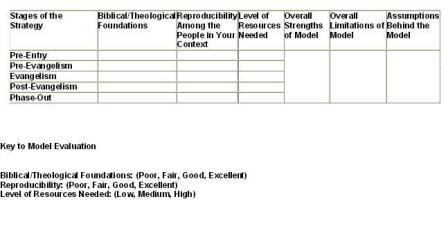In this second, and final, post (see HERE for part 1), I want to provide you with some general guidelines on how to approach varying church planting models, and hopefully escape the model mania that continues to prevail in many circles.
Tom Steffen’s article, “Selecting a Church Planting Model that Works” (Missiology 22 #3, July 1994) has been a significant influence on my thinking regarding models. So, I’ll begin with a quote from Steffen to help set the tone for this post. Steffen writes, “Every church planting model brings its own strengths and weaknesses to the church planting arena” (370).
So, with this statement in mind, let’s think strengths and limitations:
Strengths of Models:
- Models “put feet” on the concepts that surround church planting. They enable us to understand the practical nature of how evangelism and gathering together a group of believers can occur.
- Models assist us in understanding what the Lord is using in reality to birth churches.
- Models provide church planters a point of reference where they can begin their work.
Limitations of Models:
- Models are culturally specific.
- No one model is the “answer” to all the problems facing church planters.
Pan for the Golden Nuggets
When it comes to models, church planters must operate like one panning for gold. As models are examined, church planters must “sift” a great amount of “sediment” that is not going to be relevant to their context or their own personalities and gifts. However, it is in the sifting of the non-translatable aspects of various models that church planters will soon find the “golden nuggets” that will be beneficial to their work. By holding on to models lightly and thinking through what are the most likely elements of those models to be the most effective in their contexts in communicating the gospel and seeing churches born, church planters will be in a healthier position to consider the value of the world’s multitude of models.
Anyone familiar with Steffen’s aforementioned article will quickly recognize his influence on my model evaluation table below. According to the key, evaluate the particular methodology at each of your team’s five church planting stages, the overall strengths and limitations, resources necessary, and the overall assumptions behind the model.
After evaluating the paradigm you are considering using, ask yourself, “Are we being good and wise stewards with all that the Lord has provided by using this approach when it comes to the multiplication of disciples, leaders, and churches among the 4 billion people on earth who do not know Jesus?” Yeah, I know…sometimes after looking at some of the “hip” approaches to church planting in this light, things don’t always look so cool…. But who am I, when it comes to coolness….I used to have a mullet.
I hope this post has you thinking differently about approaches to church multiplication. Rather, than taking something “that worked” at face value, I hope that you now have a tool in your belt to help you and your team think contextually about your Kingdom labors.
For more information on this topic, I’ll direct you to Discovering Church Planting. A portion of this post came from there, where more details are found.

